Wonder of the Week
 Fireweed is a pioneer plant named for its tendency to colonize areas impacted by natural occurrences such as fire, landslides or avalanches plus soils disturbed by logging, petroleum extraction and surface mining. Fireweed serves an important ecological role in stabilizing upset soils. Its tiny seeds and rhizomes (underground root system) reach deep, even crack through rocks to pull minerals up from deep within the earth.
Fireweed is a pioneer plant named for its tendency to colonize areas impacted by natural occurrences such as fire, landslides or avalanches plus soils disturbed by logging, petroleum extraction and surface mining. Fireweed serves an important ecological role in stabilizing upset soils. Its tiny seeds and rhizomes (underground root system) reach deep, even crack through rocks to pull minerals up from deep within the earth.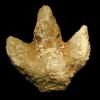 Little did we know what treasures were buried when the John Martin Reservoir in Bent County, southeastern Colorado, was constructed in 1948 for flood and water resource management of the Arkansas River. When full, the reservoir is the largest body of water in the region. In 2004-2005 , the region experienced a drought that nearly drained the reservoir entirely. Due to the drought, nearly 300 dinosaur and other vertebrate tracks were discovered in dry portions of the reservoir bed. Most of the tracks are attributed to the ichnogenus Caririchnium, which is thought to have been made by an ornithopod, aka duckbill-type dinosaur. An ichnogenus is a genus that is only known from the trace fossil, such as a track, burrowing, trail, and etc. Caririchnium is characterized by three broad toes and a large heel. Other tracks found include the ichnogenus Magnoavipes, a track possibly made by a theropod or meat-eating dinosaur, numerous crocodile swimming tracks, and the first-ever discovered pterosaur, a flying reptile, tracks from the region.
Little did we know what treasures were buried when the John Martin Reservoir in Bent County, southeastern Colorado, was constructed in 1948 for flood and water resource management of the Arkansas River. When full, the reservoir is the largest body of water in the region. In 2004-2005 , the region experienced a drought that nearly drained the reservoir entirely. Due to the drought, nearly 300 dinosaur and other vertebrate tracks were discovered in dry portions of the reservoir bed. Most of the tracks are attributed to the ichnogenus Caririchnium, which is thought to have been made by an ornithopod, aka duckbill-type dinosaur. An ichnogenus is a genus that is only known from the trace fossil, such as a track, burrowing, trail, and etc. Caririchnium is characterized by three broad toes and a large heel. Other tracks found include the ichnogenus Magnoavipes, a track possibly made by a theropod or meat-eating dinosaur, numerous crocodile swimming tracks, and the first-ever discovered pterosaur, a flying reptile, tracks from the region. Blazing Star, also called Gayfeather, is a hardy wildflower that can live for decades in Colorado’s semi-desert climate. Rising up to 4’ tall each autumn, its bright purple flowers act as magnets for monarchs, birds and busy bees, long after other summer blooms have dried up.
Blazing Star, also called Gayfeather, is a hardy wildflower that can live for decades in Colorado’s semi-desert climate. Rising up to 4’ tall each autumn, its bright purple flowers act as magnets for monarchs, birds and busy bees, long after other summer blooms have dried up.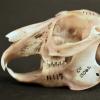 The black-tailed jackrabbit (also known as an American desert hare) is the most widely distributed hare species, occurring throughout arid regions of the Western U.S. and Northern Mexico. It is found in a variety of habitats, including shrublands, grassland prairies, open woodlands, and croplands, and even inhabits conifer forests reaching up to 10,000 ft in elevation. Oversized ears, prominent long legs and bulging eyes are characteristic of hares, and this species is marked by its black upper tail and ear tips.
The black-tailed jackrabbit (also known as an American desert hare) is the most widely distributed hare species, occurring throughout arid regions of the Western U.S. and Northern Mexico. It is found in a variety of habitats, including shrublands, grassland prairies, open woodlands, and croplands, and even inhabits conifer forests reaching up to 10,000 ft in elevation. Oversized ears, prominent long legs and bulging eyes are characteristic of hares, and this species is marked by its black upper tail and ear tips.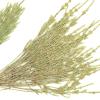 Field Horsetail is a cosmopolitan fern widespread throughout the Northern Hemisphere, found in moist sites along roadsides and riverbanks as well as in fields, marshes, pastures, and tundra. Today’s horsetails are ‘living fossils’ – miniature descendants of an ancient plant lineage that once played a dominant role in the understory of Paleozoic forests. Some of those equiseta were large trees, and their fossils are abundant in coal deposits from the Carboniferous Period, or the Age of Ferns.
Field Horsetail is a cosmopolitan fern widespread throughout the Northern Hemisphere, found in moist sites along roadsides and riverbanks as well as in fields, marshes, pastures, and tundra. Today’s horsetails are ‘living fossils’ – miniature descendants of an ancient plant lineage that once played a dominant role in the understory of Paleozoic forests. Some of those equiseta were large trees, and their fossils are abundant in coal deposits from the Carboniferous Period, or the Age of Ferns.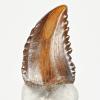 This is a tooth from a dinosaur called Troodon, a small three feet tall meat-eater that lived in North America during the Late Cretaceous Period, about 77 to 66 million years ago. The 1 mm scale gives us a clue on just how small Troodon was as this tooth is approximately 4 mm in width, its teeth were smaller than our teeth! Troodon was one of the first dinosaurs ever discovered from North America and was first described by famous paleontologist Joseph Leidy in 1856. Leidy gave this animal the name Troodon meaning “wounding tooth”. Unlike other meat-eating dinosaurs, Troodon teeth have very distinctive serrations that resemble the serrations found on the teeth of herbivorous reptiles. This suggests that Troodon may have been omnivorous (kind of like us), instead of a strict meat-eater.
This is a tooth from a dinosaur called Troodon, a small three feet tall meat-eater that lived in North America during the Late Cretaceous Period, about 77 to 66 million years ago. The 1 mm scale gives us a clue on just how small Troodon was as this tooth is approximately 4 mm in width, its teeth were smaller than our teeth! Troodon was one of the first dinosaurs ever discovered from North America and was first described by famous paleontologist Joseph Leidy in 1856. Leidy gave this animal the name Troodon meaning “wounding tooth”. Unlike other meat-eating dinosaurs, Troodon teeth have very distinctive serrations that resemble the serrations found on the teeth of herbivorous reptiles. This suggests that Troodon may have been omnivorous (kind of like us), instead of a strict meat-eater. TDA Cockerell, an entomologist at the University of Colorado who specialized in bees, was also an avid fossil collector and was the first to discover and describe many of the fossil insect from Florissant.
TDA Cockerell, an entomologist at the University of Colorado who specialized in bees, was also an avid fossil collector and was the first to discover and describe many of the fossil insect from Florissant.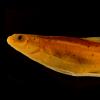 Hybognathus placitus also known as the plains minnow is a fish that inhabits many shallow river channels with the Great Plains states. The etymology behind the genus and species name are Greek for swollen jaw (Hybognathus) and broad surface (placitus).
Hybognathus placitus also known as the plains minnow is a fish that inhabits many shallow river channels with the Great Plains states. The etymology behind the genus and species name are Greek for swollen jaw (Hybognathus) and broad surface (placitus). Blanketflower is native to western North America. In Colorado, it is most common from the grassland-forest ecotone at the edge of the foothills to the upper limits of the ponderosa pine at elevations of approximately 9,000 feet. It is part of a
Blanketflower is native to western North America. In Colorado, it is most common from the grassland-forest ecotone at the edge of the foothills to the upper limits of the ponderosa pine at elevations of approximately 9,000 feet. It is part of a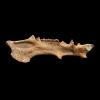 Archaeotherium is an entelodont which are extinct members of the artiodactyls (an order that includes today’s cattle, deer, and sheep) that lived alongside rhinos and early horses on the floodplains of eastern Colorado, Wyoming, South Dakota, Nebraska, and Texas during late Eocene – Oligocene time (ca. 37 – 23 million years ago).
Archaeotherium is an entelodont which are extinct members of the artiodactyls (an order that includes today’s cattle, deer, and sheep) that lived alongside rhinos and early horses on the floodplains of eastern Colorado, Wyoming, South Dakota, Nebraska, and Texas during late Eocene – Oligocene time (ca. 37 – 23 million years ago).

